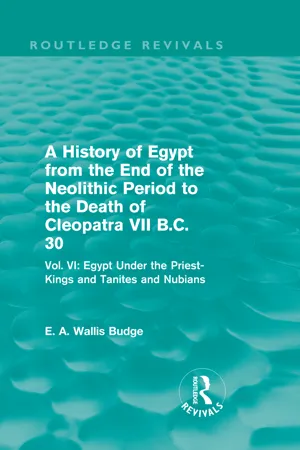
A History of Egypt from the End of the Neolithic Period to the Death of Cleopatra VII B.C. 30 (Routledge Revivals)
Vol. VI: Egypt Under the Priest-Kings and Tanites and Nubians
- 230 pages
- English
- ePUB (mobile friendly)
- Available on iOS & Android
A History of Egypt from the End of the Neolithic Period to the Death of Cleopatra VII B.C. 30 (Routledge Revivals)
Vol. VI: Egypt Under the Priest-Kings and Tanites and Nubians
About This Book
Sir E. A. Wallis Budge (1857-1934) was Keeper of the British Museum's department of oriental antiquities from 1894 until his retirement in 1924. Carrying out many missions to Egypt in search of ancient objects, Budge was hugely successful in collecting papyri, statues and other artefacts for the trustees of the British Museum: numbering into the thousands and of great cultural and historical significance. Budge published well over 100 monographs, which shaped the development of future scholarship and are still of great academic value today, dealing with subjects such as Egyptian religion, history and literature.
This volume, first published in 1902, is the sixth of eight volumes by Budge dealing with different periods in the history of Egypt. The narrative begins with the reign of Nes-ba-Tettet, the first king of the XXIst Dynasty, and ends with the third king of the XXVIth Dynasty, Psammetichus II. Covering the years 1100-600 B.C., Budge analyses how Egypt changed shape under the rule of different kings, and witnessed both decline in and consolidation of power at varying points. This rich and important period of Egyptian history is explored in a classic work of great value to those interested in Egyptology and archaeology.
Frequently asked questions
EGYPT UNDER THE PRIEST-KINGS AND TANITES AND NUBIANS.

CHAPTER I.
THE TWENTY-FIEST DYNASTY
I. KINGS OF TANIS.













Table of contents
- Cover
- A History of Egypt from the End of the Neolithic Period to the Death of Cleopatra VII B.C. 30
- Title Page
- Copyright Page
- Half Title
- Publishers' Note
- Original Title Page
- Preface
- Table of Contents
- List of Illustrations
- Errata
- Chapter I.—The Twenty-First Dynasty
- Chapter II.—The Twenty-First Dynasty
- Chapter III.—Nineteenth, Twentieth, and Twenty-First Dynasties—Summary
- Chapter IV.—Twenty-Second Dynasty. From Bubastis
- Chapter V.—The Twenty-Third Dynasty. From Tanis
- Chapter VI.—The Twenty-Fourth Dynasty. From Sïs
- Chapter VII.—The Twenty-Fifth Dynasty. From Nubia
- Chapter VIII.—The Twenty-Second to the Twenty-Fifth Dynasty—Summary
- Chapter IX.—The Twenty-Sixth Dynasty. From Saïs